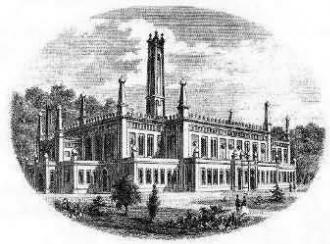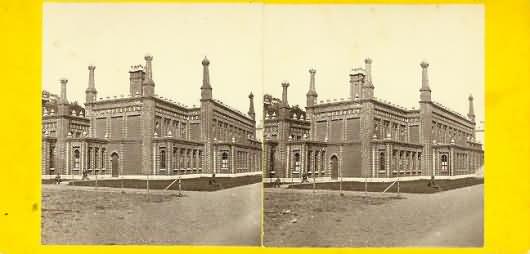Quinsborough Road, Bray, Ireland:
two complementary views

< Image, from D E Hefferman's Illustrated plan of Bray published c.1870, is reproduced from the version annotated
by K M Davies and published by Wordwell in 2000.

< Stereo images by unknown photographer, on a contemporary stereocard
The Bray Turkish baths were designed by Mr Richard Barter, architect namesake of the owner of St Ann's Hydropathic Establishment. Owned by the wealthy businessman William Dargan and operated under the supervision of Dr Richard Barter, they were officially opened by the Earl of Meath on 15 October 1859, and opened to the public a fortnight later.
An article on these baths will appear in due course
Robert Wollaston described the baths 1 as follows:
The building cost £10,000; it is
extremely handsome, of an Oriental style of architecture--of red and white
bricks alternately placed, and faced with stone. The interior is very
appropriately decorated, and composed of several apartments admirably adapted to
their respective uses. There is a grand entrance hall, or reception room,
divided into a dozen small apartments on each side of the hall, each fitted as a
dressing room, with a couch, &c, to lie down upon after the use of the Bath;
divans or couches placed around the room for the purposes of reposing, smoking,
and conversation. The ceiling is painted in arabesque, and richly colored with
the favorite Turkish colours--green, red, and blue. The windows are all of
colored glass, and the light of the apartment is most agreeably diffused by the
hues of the glass. The centre is ornamented with a handsome marble fountain;
flowers and aquatic plants, and ferns, interspersed amongst shells and
rock-work, adorn the fountain.
The flooring is richly inlaid with tesselated pavement--made for the purpose at Minton's Porcelain Works, in Staffordshire--in imitation of the pavement of ancient Baths. The warm and hot air rooms are also beautifully constructed, with marble seats and tesselated pavement; the domes are enriched with stars of variegated glass, which give a brilliant appearance. There are, in recesses connected with the hot rooms, chambers for ablution, where tepid and cold water are plentifully supplied as Shower and Dash Baths; and there are to be attendants in Turkish costume to shampoo the bathers; coffee and sherbet, cigars and pipes, will be added, to complete the whole ceremony of the Turkish mode of bathing.
The stereocard is from the collection of the Victorian Turkish Baths Project
Mary Davies
Paula Fleming, for the stereocard view of the baths
This page enlarges an image or adds to the information found below:
Urquhart and the London Hammam. Part 1: introduction
Early problems and controversies. Part 9: terminology and architectural style
The Turkish bath as a facility
Heritaging the Victorian Turkish bath

Victorian Turkish Baths: their origin, development, and gradual decline



Comments and queries are most welcome and can be sent to:
malcolm@victorianturkishbath.org
The right of Malcolm Shifrin to be identified as the author of this work
has been asserted by him
in accordance with the Copyright, Designs and Patents Act 1988
© Malcolm Shifrin, 1991-2023